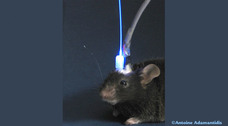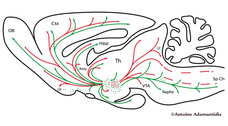
Sleep is a primary and essential biological need for higher vertebrates and “sleep-like” states have been demonstrated in lower vertebrates. Although the function of sleep is still a mystery, it may include memory consolidation, energy replenishment and brain plasticity.
Neural substrates of sleep-wake states
| Fig. 1:Schematic representation of the neuroanatomical organization of the Hcrt/Ox (red) and MCH (green) systems in the rat brain |
The neural underpinnings of sleep-wake states involve interactions between sleep-promoting areas such as the anterior hypothalamus, and wake-promoting areas located in the posterior hypothalamus, the basal forebrain and the brainstem.
Multiple sleep stages, including slow wave sleep (non rapid eye movement or NREM) and paradoxal sleep (rapid eye movement or REM), have been identified in mammals. The occurence and maintenance of those sleep stages depend on a complex interaction between highly specialized neural circuits that remain to be elucidated.
Reverse engineering of vigilance states circuits
 |
| Fig. 2: Behavioral set up for optogenetic stimulation combined to polysomnographic recording |
Research projects in the lab aim at understanding, dissecting and probing the dynamics of neural circuits that control the sleep-wake cycle in the mammalian brain.
The lab uses a combination of state-of-the-art molecular, cellular and behavioural strategies. Those include:
- genetic mouse engineering
- in vitro and in vivo electrophysiology
- optogenetics
- polysomnographic recordings and vigilance states analysis
- behavioural testing
Team
Director
Antoine Adamantidis, PhD
Graduate student
Sonia Jego (IPN, McGill University)
Contact
Please contact the lab for optogenetic support or possible collaborations.
Antoine Adamantidis, Ph.D.
Douglas Institute
6875 LaSalle Blvd, Montréal (Québec) H4H 1R3
Tel: 761-6131 ext: 6168
Fax: 514-762-3034
antoine_dot_adamantidis_At_mcgill_dot_ca



